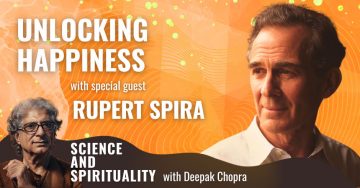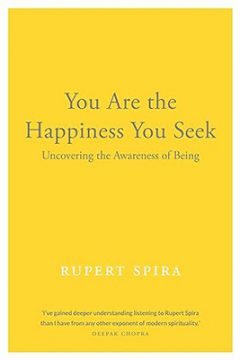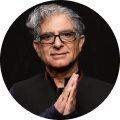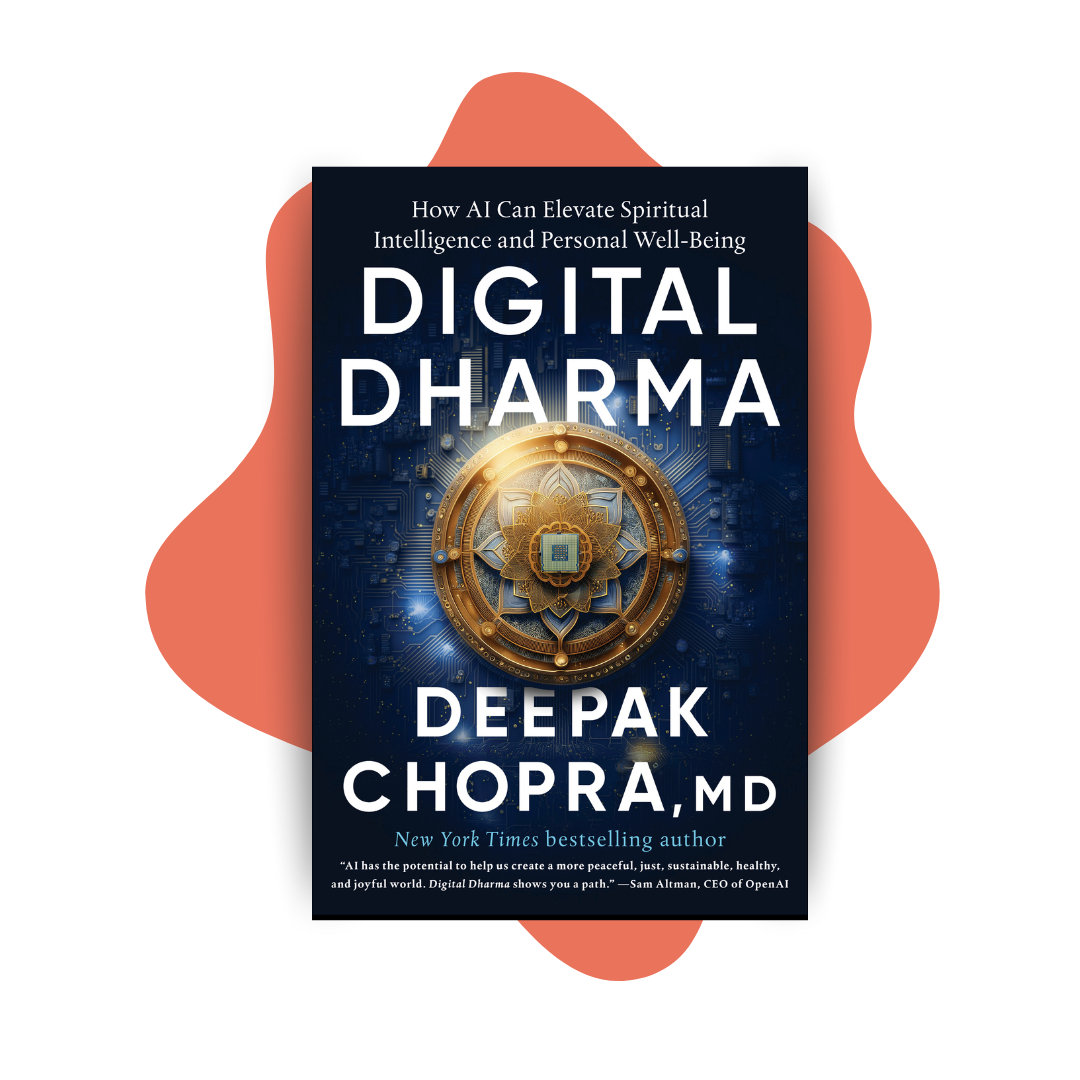Home › Podcasts › Science and Spirituality with Deepak Chopra › Unlocking Happiness with Special Guest, Rupert Spira
Unlocking Happiness with Special Guest, Rupert Spira.

Happiness can be a very elusive concept. How can we be happy in a world filled with things that make us feel otherwise? Deepak Chopra invites to the show spiritual teacher and philosopher Rupert Spira, who brings his book, You Are the Happiness You Seek: Uncovering the Awareness of Being, to shed light on unlocking happiness. In particular, they dive deep into facing painful emotions. Rupert shares the basic approaches for how we can embrace these emotions, collapsing the distance and resistance until we can no longer name them. Discover how to transcend painful emotions by going into the heart of it. Let this conversation show you a way to find the happiness that you have been seeking.
Listen to the podcast here
Unlocking Happiness with Special Guest, Rupert Spira
A Conversation with Deepak Chopra and Rupert Spira on How to Embrace Painful Emotions
I have the pleasure of having a conversation with Rupert Spira. Every time I speak to him, I learn something new. I got some ideas myself on how to explore what he’s saying in my own life because we are going to talk a little bit about this book, You Are The Happiness You Seek: Uncovering the Awareness of Being. What Rupert does more than anyone else that I know is he gives you a lived-in experience of the knowledge. It’s not knowledge you just learn. It’s the knowledge you become. Rupert, thank you for joining me.
Thank you, Deepak. It’s lovely to be with you and talk with you again, as always.
I did send a copy of the book to Oprah Winfrey. Oprah, if you’re reading this, I’ll send you another copy. I hope you can speak to Rupert sometime. Rupert, I was going through your book. There’s so much to learn in this book. It expands on some of your other amazing books. Non-duality is a difficult idea to comprehend for most people intellectually. Even when they comprehend it intellectually, they don’t feel that they can experientially become that knowledge unless they’re in the presence of a teacher or they get some guidance.
Having read this book carefully, and everyone who’s reading this, please consider reading it. Your life will be transformed. We could focus on one area because there’s so much to discuss here. We could do a whole series on the book in every chapter. I’d love to read some of these chapters and the headlines. First of all, thank you for doing this book. Secondly, I found this chapter pertaining to painful emotions.
It’s helpful experientially for people because that’s what they come for. When you say, “You are the happiness that you seek,” it implies whoever is reading this book is not happy yet. Otherwise, they wouldn’t be reading this book. They’re not happy because they think enough money or the right relationship will make them happy. They think that if they had all the health in the world, they would be happy. If they didn’t get old, they’d be happy. If there were no deaths, they would be happy. All in all, people have many reasons not to be happy.
I’ve looked at this whole notion of emotional distress over my life, and I’ve looked at it carefully because I’m a physician. Part of my job is to help alleviate suffering, and suffering is biological as well as psychological and emotional. On the other hand, what I’ve also realized is that almost universally, and I’ll stop after I give my long introduction, emotional turbulence is a result of some trauma or an interpretation of some trauma in the past.
I was talking to Gabor Maté. I said, “I don’t have any trauma in my life.” He said, “You do.” I said, “I can’t think of something.” I kept thinking of it. I realized that when I was six years old, my parents were in England, and my grandfather suddenly died. I had the fear of death. I felt abandoned and all of that. I had trauma. The memory of trauma or the other becomes anger at some point. The desire to get even becomes hostility at some point. The fear of trauma creates anxiety. The redirection of it at yourself creates guilt, shame, and humiliation. The totality of the above creates depression, which is the number one pandemic of our time.
When I was reading a book, I said, “Let’s talk about this chapter. It’s important.” It’s not that the others aren’t, but people are coming to read this book because they’re unhappy. They’re unhappy because they’re painful emotions. You have an elegant way of saying you are denying them or getting distracted, you are doing some inquiry, or you are becoming one with them.
I had my own process, which is a seven-step process. It is used to feel the emotion in your body, label it, describe it, share it, and understand it, but ultimately release it. It was quite an elaborate process. The seven steps of responsibility are being aware of it, diffusing it, telling yourself your story, looking at other people’s points of stories, doing some ritual to release it, and moving on. I’ve done that all my life effectively. I don’t harbor or hold on to any emotions. I look at them and let them pass. Your three steps here were insightful. I’ll stop now. The rest of the interview is for you to help us understand this.
In this chapter, I give two basic approaches to painful emotions. I characterize them as the Vedantic and tantric approaches. In the Vedantic approach, we turn away from the content of experience. I’m not my thoughts. I’m that which is aware of them. I’m not my feelings. I’m that which knows them. We turn away from the content of experience back towards that which knows or is aware of our experience. It’s the net-netty approach. It could be called the via negative or the way of negation, the way of turning away from the content of experience.
There is the tantric approach, which is rather the opposite. It involves a turning towards the content of the experience. In this case, our painful emotions, but not turning towards them but actively embracing them. First of all, turn towards them, welcome them, and love them. You are devouring your emotions and bringing them close so that you turn them into yourself. You turn the emotion into yourself. You dissolve the emotion in yourself.
It’s the process that’s beautifully illustrated in the Grimm’s Fairy Tale of Kiss the Toad. If you remember, in that story, the princess has a golden ball, which she loses in the royal pond. She’s upset and distraught. She’s lost her ball. She can’t get it back. A frog appears in the pond and says, “I’ll retrieve your ball for you on one condition. That is, you take me back into the castle and embrace me.” The princess, without thinking, says, “Yes, anything to get my ball back.”
The frog retrieves the ball. The princess skips back into the castle without giving the frog another thought. She’s having dinner with her father, and there’s a knock on the door. The frog appears to remind the princess of her part in the deal to embrace the frog. Rather embarrassed, she explained to her father, and the frog came to sit next to her at dinner. The frog says, “That’s fine, but it’s not enough. You said that you would embrace me.” That night, she takes the frog to bed and has the frog on her pillow with her. He reminds her that she agreed to embrace him. She embraces the frog before she falls asleep. She falls asleep and wakes up in the morning to find the handsome prince asleep in bed next to her.
The obvious analogy in relation to painful emotions is that we turn towards and embrace that which is most distasteful to us. In doing so, we find, at the heart of it, the happiness we previously sought by trying to avoid it. Most of our painful emotions are unbearable, painful, and unpleasant. We want to suppress them so we don’t fully feel them, or we want to distract ourselves from them with substances, activities, and relationships. The one thing we never do or the one thing we rarely do is turn towards them and actively welcome them rather than push them away.

Unlocking Happiness: We turn towards and embrace that which is most distasteful to us and in doing so, we find at the very heart of it the happiness we previously sought by trying to avoid it.
We embrace anything. There can be no resistance in us to the person or the thing that we are embracing. The one thing we have done all our lives is to resist painful emotions. It’s not the emotion itself that is painful. It is our resistance to it that confers pain unbearably on the emotion. It’s the resistance that is the problem, not the experience itself.
In this second approach, which I sometimes refer to as the tantric approach, we bring the emotion close enough that we can no longer even distinguish it from ourselves. When we say, “I am lonely,” in this experience, there is the feeling of loneliness, and there is the I that feels it. In the tantric approach, we turn our attention away from the loneliness, and we explore the nature of the I, the one who feels it.
In the Vedantic approach, we increase the distance between ourselves and the emotion. In the tantric approach, we collapse the distance between ourselves and the emotion. When there’s no longer any distance between ourselves and anything, we can no longer name it in the same way that the I can only see something that is at a distance from itself.
In the same way, it’s only possible to name something as an emotion or, indeed, anything else that we stand apart from and we observe it from a distance. If you bring the emotion close that you can’t stand apart from it, the emotion loses its name. We don’t even know that it is loneliness, sorrow, or depression. It is a raw, unnameable experience. It is neither pleasant nor unpleasant. In order to define something as pleasant or unpleasant, we have to separate ourselves from it and look at it from a distance. In this tantric approach, we bring the emotion close, turn towards it, and cease resisting it.
Tweet: In order to define something as pleasant or unpleasant, we have to separate ourselves from it and look at it from a distance.
Let me go a little further based on what you said. While you’re speaking about the Kiss the Toad or the Embrace the Toad, I also remember something from Rumi. He says, “The way out of the fire is through the fire.”
He’s referring to the same experience and approach.
The second thing is when you become intimate with it, you become one with it, and you can’t name it. That’s transcendence. You have transcended whatever sensation you were interpreting as an emotion because all this is a sensation.
You’ve transcended it, but not in the Vedantic sense where you have distanced yourself from it, removed yourself from it, and recognized yourself as the presence of awareness to which the emotion appears. That’s also a transcendence. In this case, you are right. It is transcendence, but you are transcending the emotion by going so far into the heart of it that you find at its very heart the happiness or the peace that you previously sought by trying to escape it. It is a transcendence. You are transcending your resistance to it. This embracing of the emotion transforms the emotion into happiness. It’s the alchemical process of turning base metal into gold.
Tweet: This embracing of the emotion transforms the emotion into happiness. It’s the alchemical process of turning a base metal into gold.
When one makes an inquiry into the nature of emotion, not just the nature of who or what is having this experience but the nature of emotion itself when you make an inquiry, when I did that, I realized that no emotion belongs to you unless you take ownership of it. If you do and you try to hold onto it, even that’s impossible because nothing ephemeral can be held onto anyway, I asked myself, “Is anger mine? Do I own anger? Do I own fear? Is it universal and I’m forcing myself to own it?”
The I can only exist by separating itself from an experience. The ego is the separate I. If we bring an emotion close to us that we can no longer stand apart from and name it sorrow, guilt, or shame, let alone call it unpleasant, we take the emotion deeply into ourselves, that the separation ceases. There simply is no separate I present any longer either to claim the emotion or not to claim the emotion. All that is present is the raw energy of the experience.
It may be intense, but because it’s intense, it doesn’t mean it’s unpleasant. There will be the intensity of the experience. Neither pleasant nor unpleasant, nor any separate self there to transcend the experience, to overcome the experience, and to embrace the experience. There simply isn’t another entity present. There is the raw experience itself. There’s nobody there to call it good or bad, right or wrong, or pleasant or unpleasant. It’s what it is.
Rupert, in yoga, the most important sentence is the second sentence. The first is now begins the teaching of yoga. The second sentence is yogas chitta vritti nirodha. It is the fluctuations of awareness that we experience as mine. Chitta is the pure awareness of where these fluctuations are coming from. Yoga is the settling down of these, which we call emotions, perceptions, sensations, images, thoughts, senses, and experiences. When they settle out, we go back to the source of all that is. We call that presence.
The entire teaching of yoga, as in that one sentence. Yoga also means a huge union with the source. When Jesus says, “My yoke is easy. My burden is light,” even though he’s going to be crucified, he’s found the source of all existence, which is beyond sadness and these fluctuations of the mind. In many ways, the Vedantic tradition, the tantric tradition, and yoga are pointing to going back to the source of all experience and knowing that when you are there, you are holy, whole, and healed. What you are putting together is a modern version and a practical lived-in experience of what yoga tantra and Vedanta Kashmir Shaivism are the same in their own ways. Would you agree?
I would, Deepak. If we were to break this down into three steps, the first step we could say is for one who is completely lost in the content of their experience. The first step is to recognize oneself as the presence of the witnessing or the observing presence of awareness, “I am the presence of awareness.” The second step is to realize that awareness is not like the sun that illuminates the earth from a distance. It’s not an aloof witness or observer that observes experience impartially from a distance. The relationship between awareness and experience is much closer. In this second stage, we could liken to a space not to which experience appears, but within which experience appears more like the sky of awareness in which the clouds of thoughts, feelings, sensations, and so on appear.
The third step and this is now what we’re talking about, is the recognition that the content of experience, in this case, painful emotions, is not known by awareness. They don’t appear in awareness, but they are made of awareness. Our emotions are not like fishes in the ocean. They’re more like currents in the ocean made of the water itself.

Unlocking Happiness: Painful emotions are not just known by awareness. They don’t just appear in awareness, but they are made of awareness.
That’s the process of devouring your emotions. What they mean is that awareness takes the emotion deeply into itself. The emotion is merged in awareness so fully that it is recognized to be only the activity of this luminous empty presence of awareness. Awareness cannot be harmed by its own activity. The ocean is never harmed by a current within it. Once the emotion has been welcomed and taken into oneself, there is no resistance left to it. We cannot be harmed or hurt by it. The emotion loses its afflictive quality. It is realized as peace. That’s the Ananda in the Vedantic tradition. The joy is the substance even of painful emotions.
Rupert, as you were speaking, and you’re giving that analogy of the fish and the current in the ocean, I had this thought and see what you think of it. It’s obvious that the current is a modified form of the ocean. The current is water, and so is the ocean. It’s a slightly modified form. The fish is a modified form of the ocean. The ocean is that fish. That’s a grosser modified form of the ocean because the fish is made out of the ocean. How could it not be?
You and I are made out of consciousness, as what we call the body and physical world, but we are made out of consciousness, as well as mind, feelings, and emotions. They’re more like the currents. The physical body and the physical appearance of the world are more like the fish, but they’re all made out of chips or pure awareness. Is that a nice way to think about it? The fish and the current are all ocean. When you fish recognize, “I am ocean,” like you and I recognize, “I am pure awareness,” the fish is liberated.
When I suggested that emotion was more like a current in the ocean rather than a fish in the ocean, I was referring to some formulations of the non-dual understanding, which I know both you and I use and are perfectly legitimate. We say that the contents of experience, thoughts, and feelings are objects appearing in awareness.
At this stage, we’re still making a distinction between the content of experience, thoughts, emotions, perceptions, and the space of awareness. In that sense, the content of the experience is like fishes in the ocean or birds in the sky, something separate from the sky. What I was trying to point out was the fact that the relationship between emotion and awareness is closer than a fish in the water. It’s more like a current. If our thoughts and feelings are currents in the ocean, the bodies in the world are like fishes in the ocean.
It’s what we call the physical body and the subtle body.
William Blake, one of one of the great tantric masters of the Western tradition, said this incredible thing. He said, “The body is that portion of the soul.” He called it the soul. He means what we mean by mind. The body is that portion of the mind that is discerned by the five senses. That’s an incredible insight. What he’s saying is that the body is the mind. It’s not made out of matter. It’s made out of mind. When perceived through the five senses and our perceiving faculties, it appears as a body.
It is the same thing as saying that the body is a species-specific perceptual activity, which in turn is a modified form of consciousness. Perceptual activity is an activity. The mind is not a noun. It’s a verb. The body is not a noun. It’s a verb. It is a gross perceptual activity, and the other is a such perception.
William Blake said another thing, which is a well-known phrase of his. He said, “Every bird that cuts the airy way is an immense world of delight enclosed by the five senses.” Every bird that flies in the sky, and by extension, every object in the world, is an immense world of delight. Ananda. The immense world is enclosed by the five senses.
He said about the body. The bird is not a physical object made out of dead, inert stuff called matter. It’s, in his words, an immense world of delight. He’s referring to the Sanskrit word, Ananda, the being consciousness and joy. What he’s saying is what the bird is. It’s this infinite, aware, joyful being enclosed by the five senses. It looks like a bird.
When this bundle of joy made out of pure consciousness is perceived through our limited perceiving faculties, it appears to us as a bird, and it appears to be something finite, temporary, and limited. The thing in itself is not something finite, temporary, and limited. It is infinite consciousness. It’s only our senses that make it appear to be something finite, and likewise, the body. The body is that portion of the mind that is when it is perceived through the five senses.
Tweet: There is not something finite, temporary, and limited. It is infinite consciousness. It’s only our senses that make it appear to be something finite.
Was it Blake who said, “We’re led to believe alive when we see with and not through the eye?”
When we think that we see with the eye, we see a corresponding multiplicity and diversity of objects. When we realize we see through our sense perceptions and our sense perceptions confer their own limitations on reality, we realize that what we’re looking at is the appearance of the one infinite being. From the same tradition, William Wordsworth said a part of a marvelous poem he wrote. He said, “Therefore, am I still a lover of the meadows, the woods, mountains, and all that we perceive of this green earth? All the mighty world of eye and ear, both what they half create and half perceive. I am pleased to recognize in nature and the language of the sense, the anchor of my purest thoughts, the nurse, the guide, the guardian of my heart and soul of all my moral beings. This beautiful phrase, both what they half create and half perceive.”
What he’s saying is what we are looking at when we look at the world, which is the one infinite reality. That’s not created by our minds. That precedes our minds and is independent of our finite minds. We perceive reality, but we create its appearance. When you look at white snow through orange-tinted glasses, it appears orange. The snow precedes being perceived through the glasses, but it gets its orange color from the glasses. We half perceive what’s there, the white snow. We half-created the orange color. What Wordsworth is saying is that the world, as we see it, is half perceived. That is its reality, and it’s half-created. It owes its apparent limitations to our perceiving faculties.
I’m speaking with Rupert Spira. We’re only focusing on one particular chapter in this book, which is on attending to painful emotions. This book has a wealth of gems for you to know yourself ultimately as the wholeness of existence. I read the headline introduction, A Silent Prayer, chapter 1) The Search for Happiness. Chapter 2) Know Thyself. Chapter 3) Are You Myself? Chapter 4) The Art of Self-Inquiry. Chapter 5) The Essence of Meditation. Chapter 6) The Ultimate Prayer. Chapter 7: The Silent Presence of Awareness. Chapter 8) The Open, Empty, Aware Space. Chapter 9) Peace and Happiness are our Nature. Chapter 10) A Belief in Separation.

Unlocking Happiness: You Are The Happiness You Seek
Chapter 11) There is Only One Self. Chapter 12) Who Is It That Suffers? Chapter 13) Our Innate Happiness. Chapter 14) Suffering is Our Own Activity. Chapter 15) The Way of Surrender. Chapter 16) Take Refuge in the Now. Chapter 17) Attending to Painful Emotions. Chapter 18) The Unity of Being. Chapter 19) The All Pervasive Spirit, and an Invitation. As I was reading these chapters, I thought that even as I was reading this, this could be a series of conversations on this book, but Rupert, at some point, I’m going to start some masterclasses on these subjects. Maybe we can do something together on these masterclasses.
I would love to Deepak. I would be happy.
Important Links

